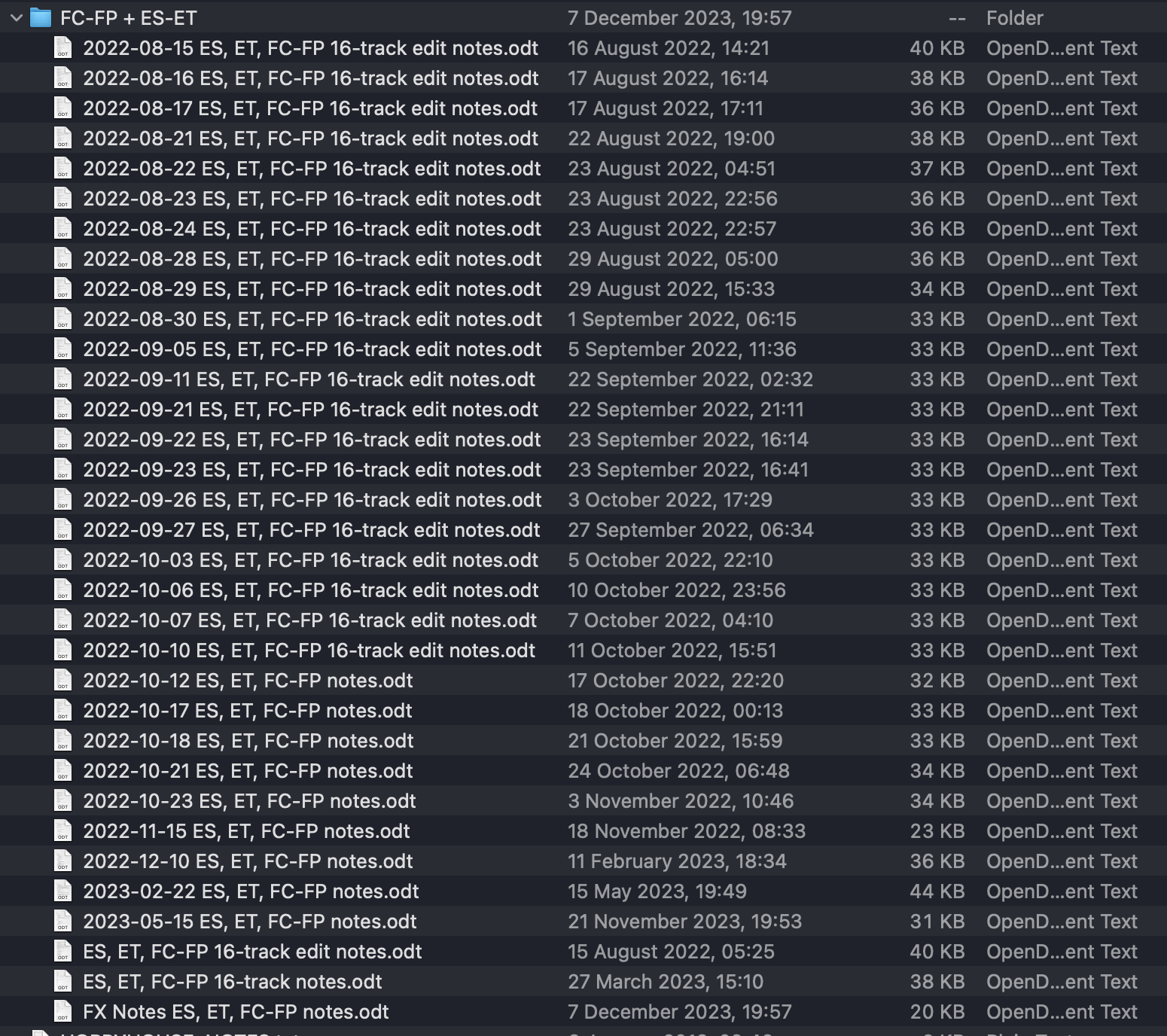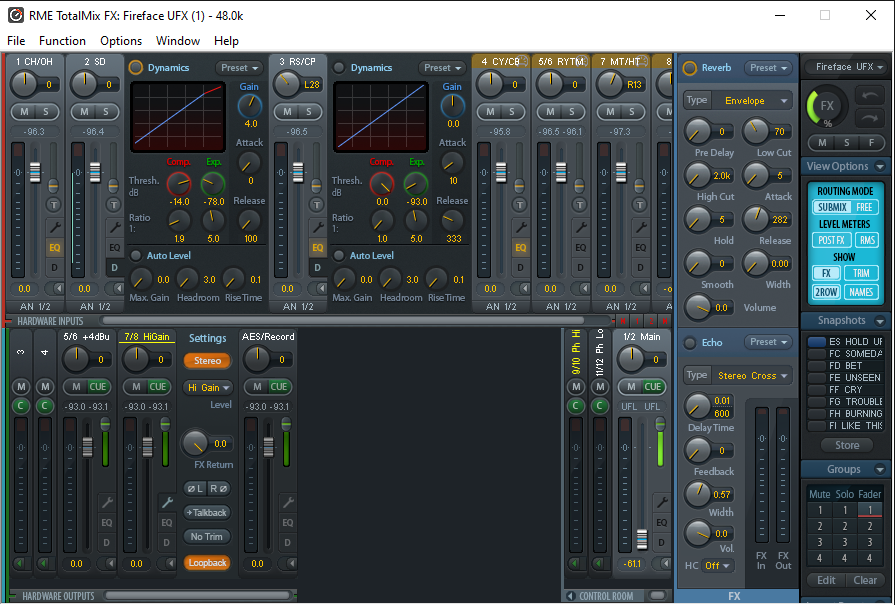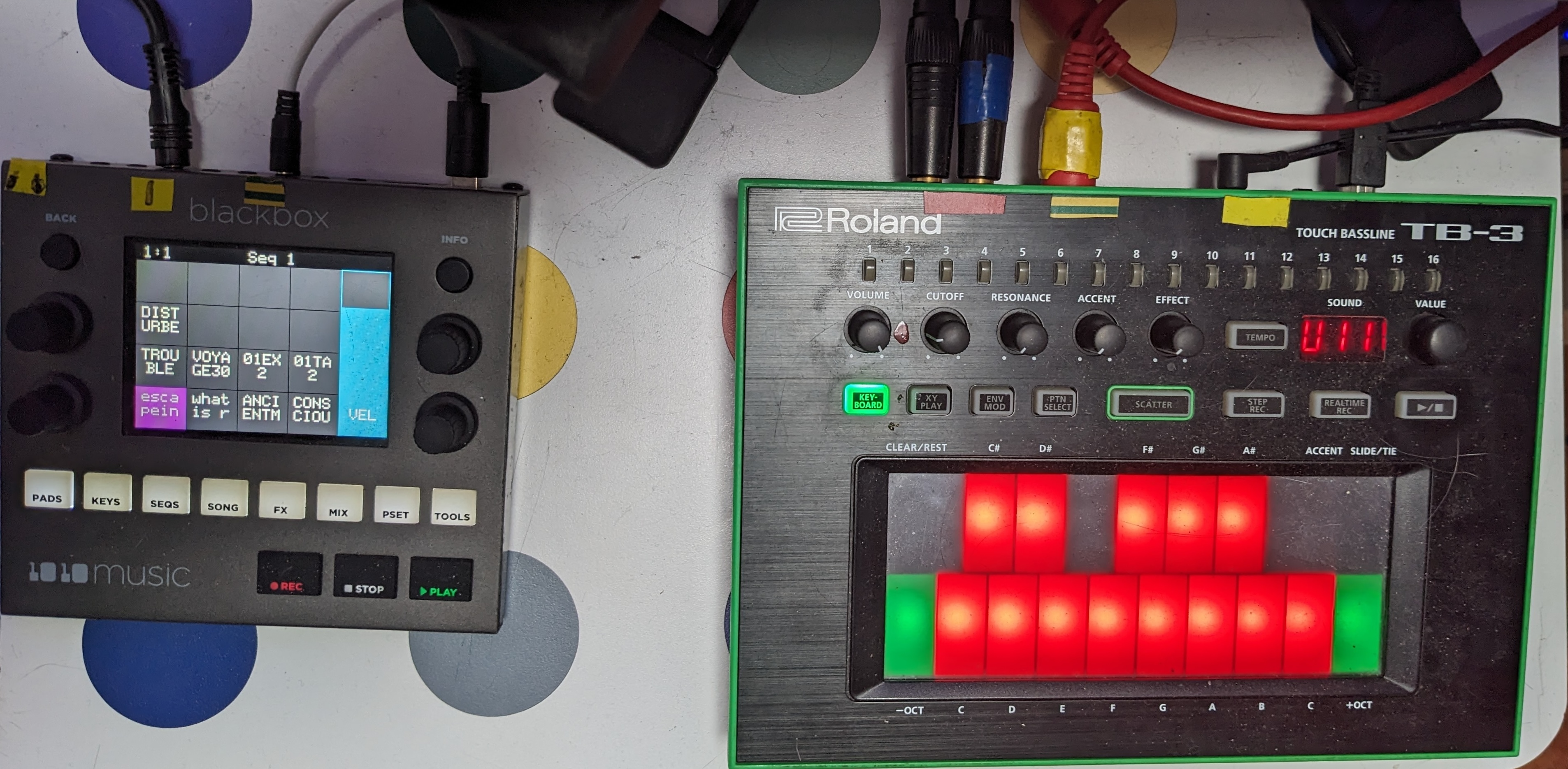A Herculean Task: Producing 3 Albums DAWlessly — Part 2
In the previous blog post, I talked about my “DAWless” production setup and in this one, I’ll go into more detail and discuss some issues and limitations that I had to overcome to record these albums.
The Issues
#1: The MPC
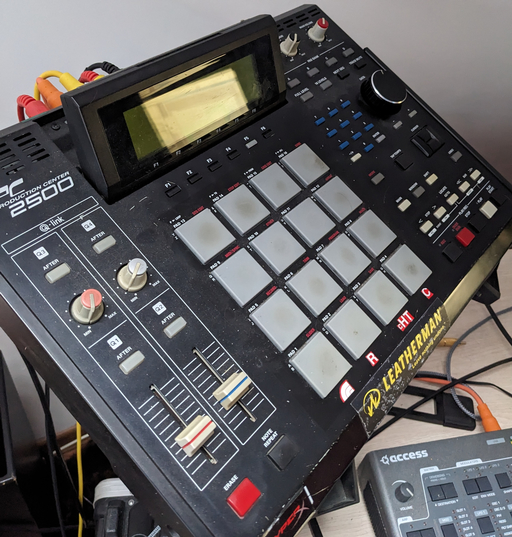 The MPC, as great at it is, is limited in that it only has 64 tracks, which may seem like a lot, but it’s not when you’re making different variations of a pattern or experimenting with different instrumentation. And the only way to make room for new patterns when you run out of tracks is to delete and/or move them, which is a laborious and time-consuming physical process which wears out the hardware and wears out the user. Yes, copy and paste is easy, but it becomes problematic when you have to transfer this change to fifty, sometimes sixty sequences. And as things inevitably get moved around and deleted, their position in the track order changes. This is extremely problematic because before any show, when it’s time to convert these longer songs into single MIDI sequences for live performance, all tracks must be in the same “lanes” so to speak and it is a very long process of reorganizing a track for conversion. Some of these tracks have required 5 or more “reorganizations” before they reached a final state, which can sometimes take half a day or more to complete. I made frequent new versions and many backups during this time because it can be easy to blow past the original idea onto something different, and I think that’s generally a bad idea. So if it happens, I can go back and start again with a previous version. It’s also important to have backups because during long composition sessions, things can get accidentally lost or overwritten, and backups keep that from becoming an unrecoverable problem. Essentially, the MPC is a very inefficient way to record, archive, and organize many multiples of tracks, so next time I will surely use my DAW or other tools to help with some of these things.
The MPC, as great at it is, is limited in that it only has 64 tracks, which may seem like a lot, but it’s not when you’re making different variations of a pattern or experimenting with different instrumentation. And the only way to make room for new patterns when you run out of tracks is to delete and/or move them, which is a laborious and time-consuming physical process which wears out the hardware and wears out the user. Yes, copy and paste is easy, but it becomes problematic when you have to transfer this change to fifty, sometimes sixty sequences. And as things inevitably get moved around and deleted, their position in the track order changes. This is extremely problematic because before any show, when it’s time to convert these longer songs into single MIDI sequences for live performance, all tracks must be in the same “lanes” so to speak and it is a very long process of reorganizing a track for conversion. Some of these tracks have required 5 or more “reorganizations” before they reached a final state, which can sometimes take half a day or more to complete. I made frequent new versions and many backups during this time because it can be easy to blow past the original idea onto something different, and I think that’s generally a bad idea. So if it happens, I can go back and start again with a previous version. It’s also important to have backups because during long composition sessions, things can get accidentally lost or overwritten, and backups keep that from becoming an unrecoverable problem. Essentially, the MPC is a very inefficient way to record, archive, and organize many multiples of tracks, so next time I will surely use my DAW or other tools to help with some of these things.
#2: The Size of the Projects
There’s an enormous amount of information that needs to be stored, backed up, and tracked for these albums: Hundreds of different sequences. Dozens of different versions of patches spanning multiple hardware machines. Dozens of different audio recordings. Hundreds of hours tweaking patches. Dozens of documents (see right) containing information like where drum kit versions are, where Virus patches are stored, which effects are in use, etc. And of course, all this information needs to be backed up to computer regularly so that data loss isn’t a death sentence. (I only use hardware machines that are fairly common so that if a device fails, it can be replaced and reloaded with all the relevant sounds with minimal delay.) And on top of that, this project spanned three genres and over two dozen songs, and was interspersed with multiple live shows, studio recordings, my daily street performances, two house moves, a tour to Africa, and so much more. It was a case of information overload and organizational struggle multiplied by project size. The sizeable time commitment was unreal too, as the very first of these beats were written in December of 2020 and January 2021, putting these projects at the 3+ year mark, many multiples of the time it took to produce my previous 3-5 song EPs. And this was all happening while I was compiling the documentation and writing the software for the Roland TB-3!
#3: Limitations in Hardware/Software
UFX & TotalMix
The RME UFX is an audio interface with a very flexible digital mixing software called TotalMix. Any input can be routed to any output via submixes, and each of the inputs and outputs has its own compressor/gate and EQ. Each output channel can also be recorded using its loopback feature. In my case I send a +4dB level to the 5/6 analog outputs and a +10dB level to the 7/8 outputs. Those outputs are also mirrored to headphone outputs 9/10 and 11/12 so that I can connect to either the front or back panel outputs for live shows. The front panel (headphone) outputs are preferred though because they are easily accessible and require a single cable connection. (You can see this routing on the image on the left.) Even though I have Compressor & EQ available on the main mix outputs, I try to keep the TotalMix modifications as small as possible, so that if I’m ever in a situation where my audio interface fails, I can still more or less play a show through a regular 16 channel house mixer and not have it sound completely different. So far so good, right?
Well, the main limitation with TotalMix is that it contains only one reverb/delay per snapshot which is shared for all inputs and outputs. A single effect shared amongst 14 channels could be a dealbreaker, but all the other instruments have built-on effects, so the effect is somewhat mitigated. But “adding a touch of reverb” to some elements in a mix has to be done on the instrument, since I don’t have the RYTM or Virus wired up to process external signals. In addition, TotalMix currently only allows eight snapshots (mixes) to be recalled instantly without loading a new workspace. To use more than eight snapshots, a new workspace has to be loaded. This is why my live sets are almost always eight tracks long. I do occasionally make longer sets, but I either try to combine them or if not possible, I load a new workspace sometime during the set to have more snapshots available.
Virus
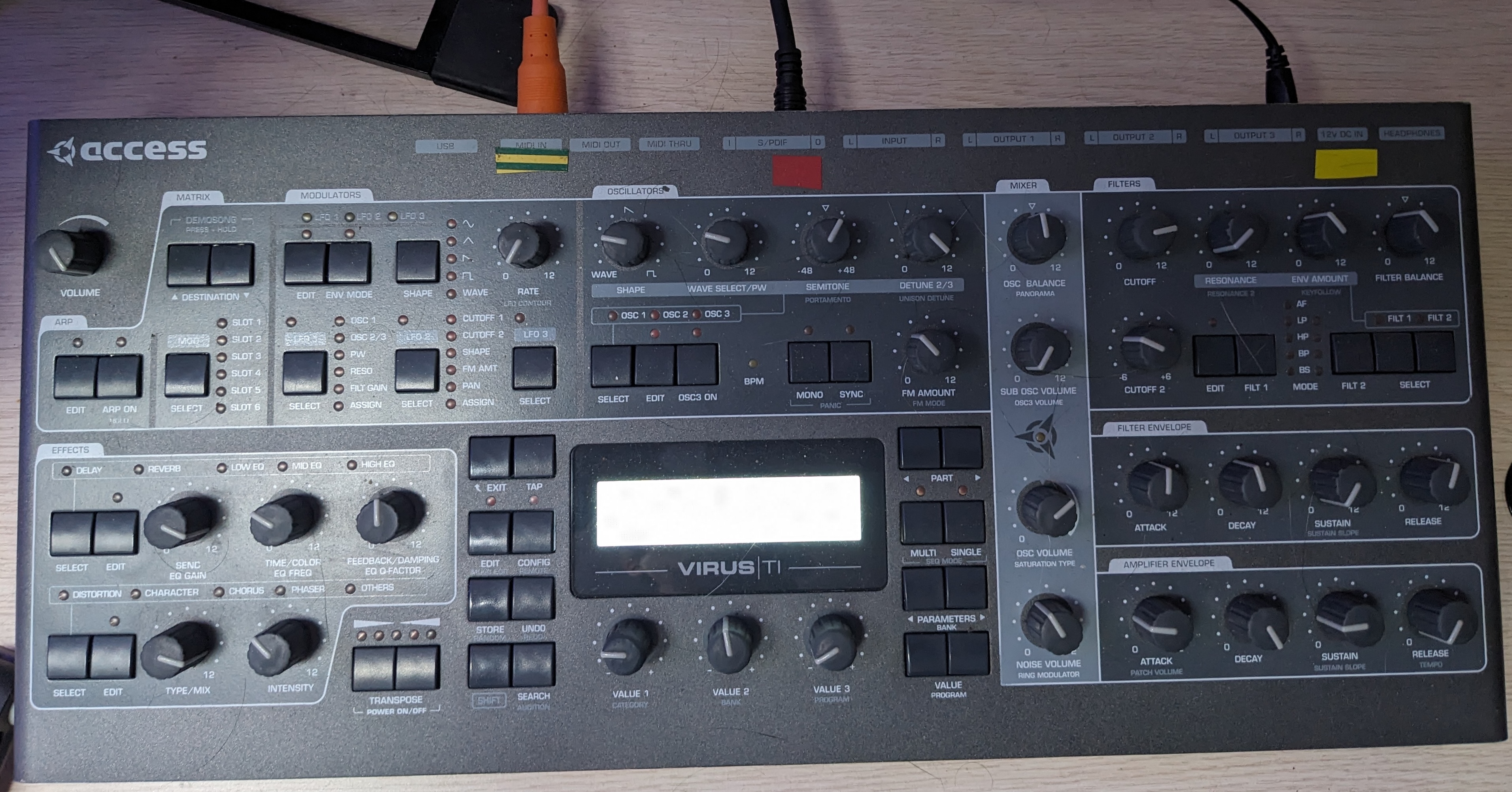 The Virus is an amazing machine with over 500 user RAM locations and 26 more banks of 128 sounds that can be burned to ROM locations. It also has dozens of VA voices that can be used before the CPU starts to cut off notes. But even with this amount of space and voices, notes still cut off in complex combinations of patches and patch space still runs out fairly quickly. The Virus is usually what I use for any type of melodic sound, from bass to arp to keys, but I only use the stereo digital output, so the sound usually cannot be altered any further once it leaves the machine, since any master effect will apply to all sounds on the channel. Also, there is no compressor on the Virus, but there is EQ and saturation which can accomplish some of the same things. So now I have banks of patches that contain variations of sounds that I’ve backed up to the computer for each song, and I do a full machine backup about once a month and keep a regularly-updated written inventory that documents which patches are pointed to by the multis. This process helps prevent data loss and is absolutely essential for a live-only artist, and has saved me many times.
The Virus is an amazing machine with over 500 user RAM locations and 26 more banks of 128 sounds that can be burned to ROM locations. It also has dozens of VA voices that can be used before the CPU starts to cut off notes. But even with this amount of space and voices, notes still cut off in complex combinations of patches and patch space still runs out fairly quickly. The Virus is usually what I use for any type of melodic sound, from bass to arp to keys, but I only use the stereo digital output, so the sound usually cannot be altered any further once it leaves the machine, since any master effect will apply to all sounds on the channel. Also, there is no compressor on the Virus, but there is EQ and saturation which can accomplish some of the same things. So now I have banks of patches that contain variations of sounds that I’ve backed up to the computer for each song, and I do a full machine backup about once a month and keep a regularly-updated written inventory that documents which patches are pointed to by the multis. This process helps prevent data loss and is absolutely essential for a live-only artist, and has saved me many times.
RYTM
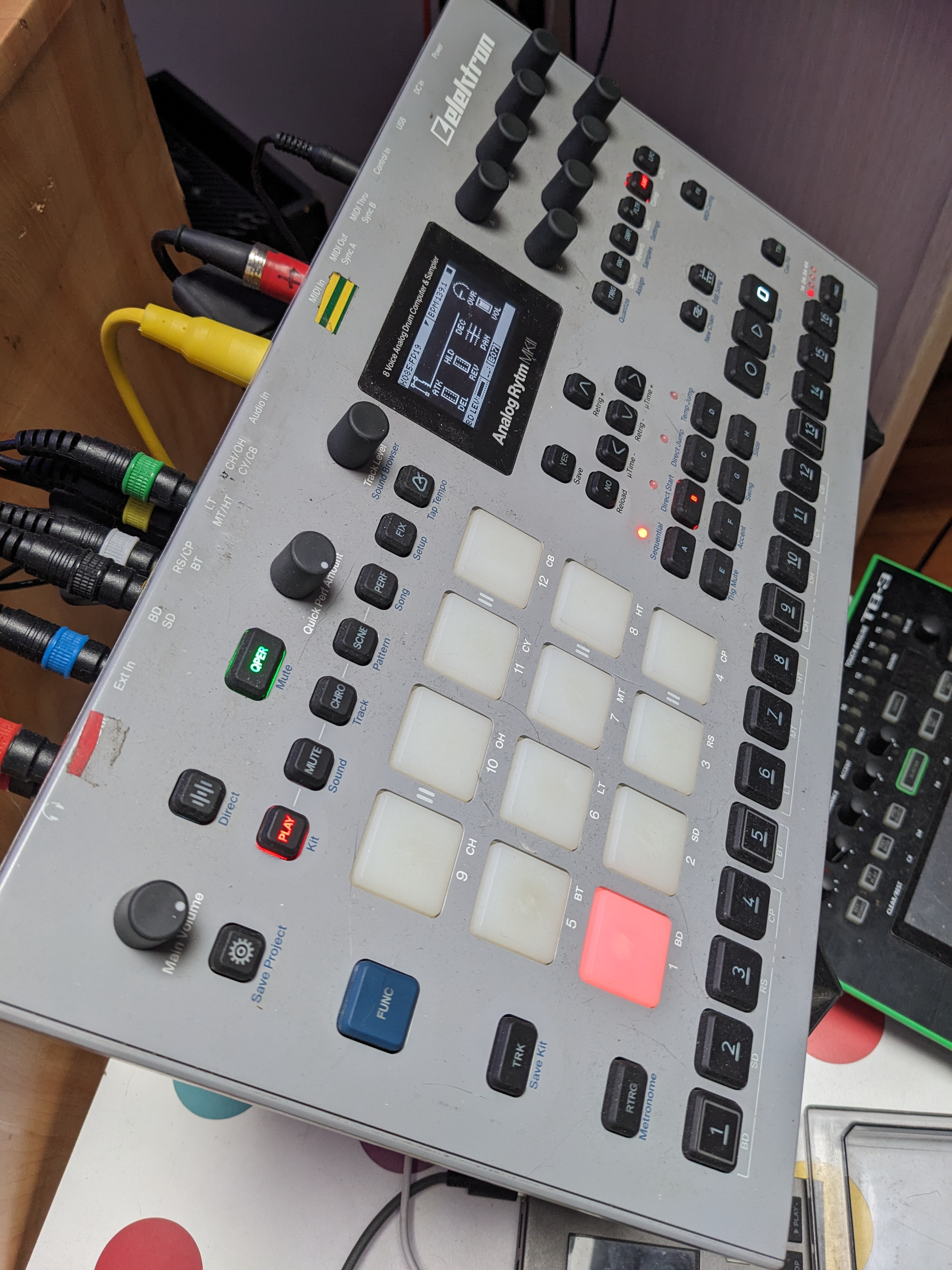 For the drum machine I have the snare, hihats, rimshot/clap, mid/hi tom, and cymbal/cowbell routed to individual outputs. On the main RYTM stereo output, I put kick, bass tom, low tom, and onboard effects. So I essentially send the low end and fx to the stereo output and the rest of the instruments to individual outputs to be modified separately. The RYTM has one master compressor/overdrive section. I use the overdrive section often, but even though it is powerful and I’m sure sometime in the future I will use more of it, for now I use the compressor very sparingly, if at all. I do this for a few reasons: 1) I need to keep a constant loudness throughout the songs from all eras of production since any of them can be potentially be performed live and 2) if there are frequency overlap or transient problems, I fix them with sound design instead and 3) the compressor is applied to the entire main stereo output (including effects), which is almost never the intended outcome. Other than managing backups and kits, which is fairly easy to do on the RYTM, the other main limitation is that it only has one master reverb/delay that is shared amongst all instruments.It just reminds me that in the recording and composing process, a few sounds done well is usually better than a lot of sounds all trying to work together. And one effect done well usually works better than a lot of effects competing for space in a mix.
For the drum machine I have the snare, hihats, rimshot/clap, mid/hi tom, and cymbal/cowbell routed to individual outputs. On the main RYTM stereo output, I put kick, bass tom, low tom, and onboard effects. So I essentially send the low end and fx to the stereo output and the rest of the instruments to individual outputs to be modified separately. The RYTM has one master compressor/overdrive section. I use the overdrive section often, but even though it is powerful and I’m sure sometime in the future I will use more of it, for now I use the compressor very sparingly, if at all. I do this for a few reasons: 1) I need to keep a constant loudness throughout the songs from all eras of production since any of them can be potentially be performed live and 2) if there are frequency overlap or transient problems, I fix them with sound design instead and 3) the compressor is applied to the entire main stereo output (including effects), which is almost never the intended outcome. Other than managing backups and kits, which is fairly easy to do on the RYTM, the other main limitation is that it only has one master reverb/delay that is shared amongst all instruments.It just reminds me that in the recording and composing process, a few sounds done well is usually better than a lot of sounds all trying to work together. And one effect done well usually works better than a lot of effects competing for space in a mix.
TB-3 & BlackBox
The TB-3 and BlackBox are each routed to a dedicated analog stereo input on the front of the audio interface. For the TB-3, I invented a way to back up and recall patches from the MPC, but patch backup and retrieval isn’t nearly the issue that it is with the Virus and RYTM. At the end of the projects, I back up all the created TB-3 patches to a computer using my TB-3 Editor software so I can quickly run through patches in the future when I want a new sound. As for the BlackBox, I use it just for vocal samples which are loaded onto it by SD card, so it too is not complicated to backup and maintain, other than having to carefully design the directory tree so that projects can be recalled properly with MIDI. All in all, these two machines, though important, didn’t cause many headaches with this DAWless approach.
And Now, On To the Mixing, Composing, and Arrangement
Come back next week when we talk about what the mixing process is like for this live-oriented, DAWless, production setup.
